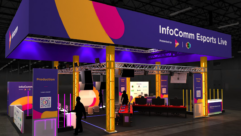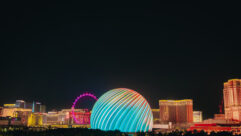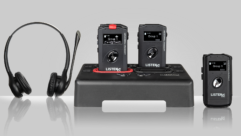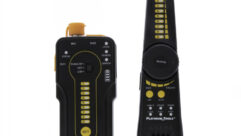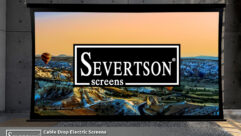

Parallax View of InfoComm 2011
Not to toot his own horn, but PRO AV’s Parallax View columnist has a good idea of the major tech trends at this year’s InfoComm show. After all, he wrote the coursework on many of them.
This month, our industry’s most important trade show takes place in Orlando, Fla. InfoComm runs the week of June 13 and, by all indications, it’s going to be chock-full of “must-see” products and vendors, not to mention the usual top-notch course offerings, pavilions, and special events. There is lots of stuff to pack into three days (or five days, if you add in Super Tuesday sessions and the Projection Summit).
Having seen what’s coming down the pike at the Consumer Electronics Show (CES), Hollywood Post Alliance (HPA) Tech Retreat, and the National Association of Broadcasters (NAB) Show, I have a good idea of the display trends you’ll want to monitor at the Orange County Convention Center.
A big trend this year, and one that keeps gaining steam, will be IPTV–streaming video, “over-the-top” video, or whatever you want to call it. You will see ample quantities of digital video encoders, decoders, and integrated receiver/decoders (IRDs) from companies such as Haivision, VBrick, Evertz, and Harris. IPTV was a big part of the NAB Show, and not just for traditional media distribution. We’ve clearly stepped beyond the era of wiring distributed video systems with analog cabling. These days, converting everything to digital and installing pipes that are large enough to move high-definition files is where it’s at. The most obvious applications would be digital signage and videoconferencing, but you can think of plenty more digital distribution scenarios that would apply in retail, education, telemedicine, entertainment, and hospitality.
The most popular codec format will be MPEG-4 AVC (H.264), which is becoming a bedrock format for IPTV networks. It is also the basis of most Internet TV streaming services, such as Netflix, and is the codec of choice for Blu-ray discs. If this all sounds like Greek to you, I will once again be teaching my digital video course on Thursday, June 16, to help get you started (course IS058, beginning at 8 a.m.).
Another trend that is slowly trickling into our market is wireless video and audio connectivity. No, I’m not talking about Netflix streaming over WiFi, although that certainly qualifies. What you need to keep an eye on is high-bandwidth connectivity–streaming at full HDMI data rates (at least 8 Gbps) to and from wirelessly connected media players, TVs, computer and video monitors, multichannel audio receivers, and other HDMI- and DisplayPort-equipped devices. (It just so happens, I’ll be teaching a class on this topic, too, with a couple of live demos. It’s course IS011 on Wednesday, June 15, starting at 8 a.m.).
In the world of display technology, we’re starting to see installs switching from front projection to large LCD and plasma monitors. It’s still too soon to call this a clear trend, but the writing is on the wall, as larger and larger LCD glass cuts start shipping to North America. Sharp launched a 70-inch 1080p LCD TV for the consumer channel in April and Samsung showed a 75-inch LCD at CES. Don’t be surprised to see at least prototypes of each for the pro AV market in Orlando, along with Panasonic’s 65-inch, 85-inch, and 103-inch pro plasmas.
For a couple months now, I’ve been soliciting comments on the use of flat panels versus projectors on Pro AV’s LinkedIn group, and the consensus is that front projection is still the way to go–for now. Once LCD manufacturers address backlight aging and move exclusively to using LEDs, I think we will see the pendulum start to swing the other way.
Large LCD monitors are quickly becoming mainstays for data and videowalls, and there will be plenty of those at the show. Command and control remains a big market for tiled displays in general, but the question is, when will this market move more aggressively away from DLP rear-projection cubes to LCDs? Samsung, Barco, Christie, Orion, and Mitsubishi are all active players in this space, as is Prysm with its laser-powered phosphor displays.
Maybe we’ll even get lucky and see Samsung’s 3D wall, or a stripped-down version of Sony’s 92-foot passive stereoscopic wall that the company demonstrated at CES. Christie also showed a 3D tiled display at NAB–expect that to pop up at InfoComm. LED/DLP projection cubes, such as Christie’s Entero, will also be an area for growth as display manufacturers try to extend the mean time between failure (MTBF) for these products.
Sony got everyone’s attention with a new line of organic light-emitting diode (OLED) broadcast monitors at the HPA Tech Retreat and followed up with professional versions at NAB. There are currently two sizes–17 and 25 inches–and they produce beautiful images. They’ll cost you a pretty penny, too, but the pro versions are about one-quarter the price of the broadcast ($4,100 and $6,100 respectively).
Panasonic also showed a 42-inch reference plasma monitor at NAB, the first it’s ever manufactured. Hopefully it will make an appearance in Orlando, even though the product won’t ship until the fall. There’s a 50-inch version in the works as well.
Short-throw projectors are all the rage, especially in classrooms. Hitachi has a new 2,500-lumen short-throw (iPJ-AW250N) wide XGA projector that made an appearance in Las Vegas and can be coupled with a touchscreen sensor. Short of moving to large flat-screen displays, these projectors make sense for classrooms and conference rooms that need a more compact installation profile. Sanyo and Epson are also heavyweights in short-throw.
Connecting everything together is another story, and one trend you should definitely check out is the HDBaseT standard. HDBaseT has been adopted by AMX, Atlona, Kramer, Crestron, Extron, and Gefen, with more manufacturers waiting in the wings. HDBaseT can carry HDMI, RS-232, IR control, and symmetrical 100BaseT Ethernet over Cat-5e cables up to a maximum of 330 feet. Think about that: An HDBaseT router also becomes an Ethernet router. This means that existing structured-wire pulls can be upgraded to multimedia ports. If you’ve installed older UTP transmitters and receivers for applications as mundane as moving RGBHV video and plenum audio around, you now have an easy and quick path to full 1080p/60 HD video and digital audio.
Oh, and did I mention? I’ll touch on HDBaseT briefly during my Super Tuesday Display Technology Trends session, at (that’s right) 8 a.m. on June 14, along with some other cool products and trends from CES and NAB. When it comes to the emerging technologies that impact pro AV, the early bird gets the worm. See you in Orlando.


